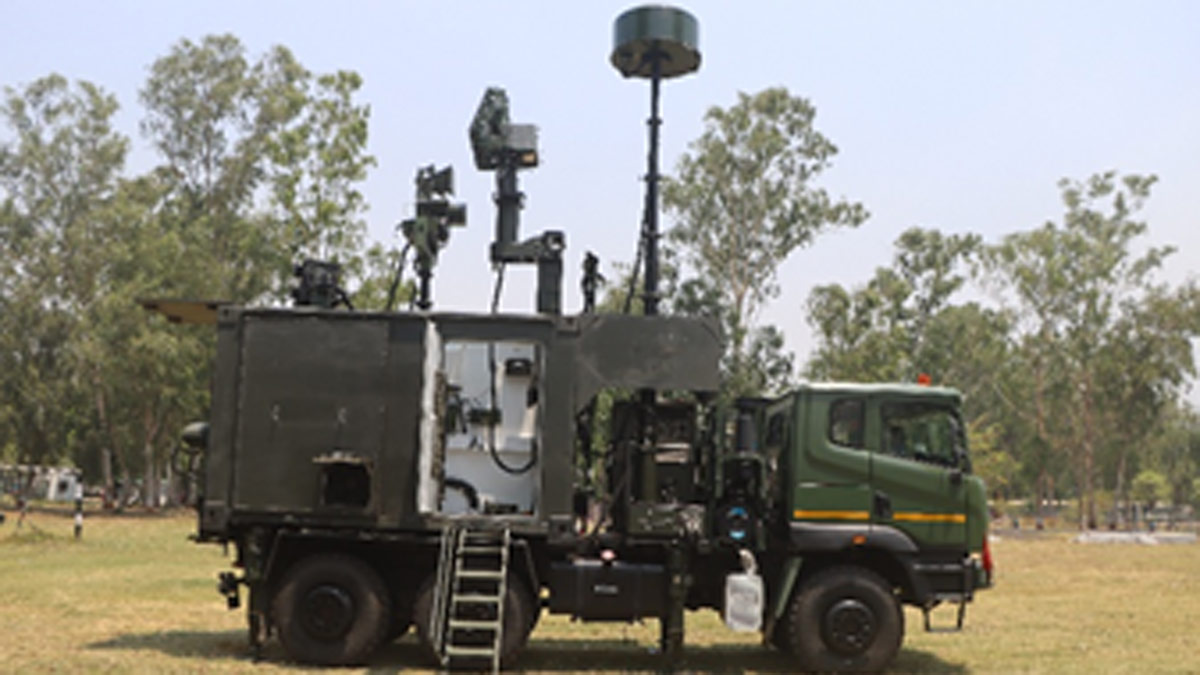- Courses
- GS Full Course 1 Year
- GS Full Course 2 Year
- GS Full Course 3 Year
- GS Full Course Till Selection
- Online Program
- GS Recorded Course
- NCERT (Recorded 500+ Hours)
- Polity Recorded Course
- Geography Recorded Course
- Economy Recorded Course
- AMAC Recorded Course
- Modern India, Post Independence & World History
- Environment Recoded Course
- Governance Recoded Course
- Science & Tech. Recoded Course
- International Relations and Internal Security Recorded Course
- Disaster Management Module Course
- Ethics Recoded Course
- Essay Recoded Course
- Current Affairs Recoded Course
- CSAT
- 5 LAYERED ARJUNA Mentorship
- Public Administration Optional
- ABOUT US
- OUR TOPPERS
- TEST SERIES
- FREE STUDY MATERIAL
- VIDEOS
- CONTACT US
Akashteer – India’s Indigenous Automated Air Defence Control and Reporting System
Akashteer – India’s Indigenous Automated Air Defence Control and Reporting System

- In the dark skies, a new kind of warrior awakened.
- It did not roar like a fighter jet or flash like a missile.
- It listened. It calculated. It struck.
- This invisible shield, Akashteer, is no longer a concept confined to defence journals.
- On the night of May 9–10, 2025, during a large-scale cross-border aerial attack from Pakistan, Akashteer successfully intercepted and neutralised every inbound drone and missile, proving its combat efficacy.
- Akashteer is India’s fully indigenous, automated Air Defence Control and Reporting System, that intercepted and neutralised every inbound projectile.
- The system represents a major milestone in India’s transition from manual and radar-based air defence to an integrated and real-time automated response system.
Key Features of Akashteer
System Type and Purpose
|
Parameter |
Description |
|
Role |
Detection, tracking, identification, and engagement of aerial threats including aircraft, drones, and missiles |
|
Integration |
Part of India’s broader C4ISR ecosystem (Command, Control, Communications, Computers, Intelligence, Surveillance and Reconnaissance) |
|
Platform |
Vehicle-mounted, ensuring mobility and rapid deployment in active conflict zones |
Technological Components
|
Component |
Function |
|
Tactical Control Radar (REPORTER) |
Real-time tracking of low-level aerial targets |
|
3D Tactical Control Radar |
Multi-target surveillance and classification |
|
Low-Level Lightweight Radar (LLLR) |
Detection of low-altitude threats in complex terrains |
|
Akash Weapon System Radar |
Engages and guides Akash missiles for target interception |
|
Communication Nodes |
Facilitates seamless communication across units and command centers |
Operational Capabilities
- Provides a real-time common air picture across control rooms, radar sites, and ground-based weapon systems.
- Ensures automated engagement of aerial threats, reducing human response time and errors.
- Allows for coordinated and distributed targeting, minimising the risk of friendly fire.
- Supports autonomous surveillance and response in low-level airspace and high-conflict zones.
Strategic Integration with Armed Forces
- Forms the core of Indian Army’s Air Defence (AAD) command.
- Fully interoperable with:
- IACCS (Integrated Air Command and Control System) – Indian Air Force
- TRIGUN System – Indian Navy
- Facilitates tri-service integration and situational awareness, ensuring real-time threat analysis and coordinated defence.
Comparison with Adversaries
|
Country |
System |
Observations |
|
India |
Akashteer |
Indigenous, automated, real-time system. Demonstrated success in actual combat. |
|
Pakistan |
HQ-9 and HQ-16 (imported from China) |
Reportedly failed to detect or intercept Indian strikes during recent engagements. |
Strategic Importance
- Enables India to shift from reactive to proactive air defence strategy.
- Reduces dependence on foreign platforms, aligning with Atmanirbhar Bharat vision.
- Demonstrates India's ability to lead in next-generation warfare systems.
- Reduces human error and response delays during real-time combat operations.
Indigenous Defence Ecosystem Supporting Akashteer
- Akashteer is part of a broader indigenous defence platform ecosystem developed under the Make in India and Atmanirbhar Bharat initiatives.
- Notable Indigenous Systems and Platforms:
- Dhanush, ATAGS, MBT Arjun – Artillery and Main Battle Tanks
- LCA Tejas, ALH, LUH – Light combat and utility aircraft and helicopters
- Weapon Locating Radar, 3D Tactical Control Radar, SDR – Advanced sensor and communication systems
- Naval assets: Indigenous aircraft carriers, destroyers, frigates, corvettes, fast patrol vessels
Defence Industrial Growth (as of 2025)
|
Parameter |
Data |
|
Target for Defence Production by 2029 |
₹3 lakh crore |
|
Contribution of Private Sector |
21% of total defence output |
|
Indigenous Manufacturing (Current) |
65% of defence equipment (earlier import dependency: 65–70%) |
|
Defence Public Sector Units (DPSUs) |
16 |
|
Licensed Private Companies |
Over 430 |
|
MSMEs in Defence Sector |
Approx. 16,000 |
Way Forward
- Expand deployment across conflict-sensitive regions and border zones
- Integrate with more autonomous and AI-driven subsystems
- Continue R&D for next-generation sensor fusion and faster data processing
- Enhance defence exports of command-and-control systems to friendly nations
Build technical capacity and training modules for air defence operators
|
Also Read |
|
| FREE NIOS Books | |




